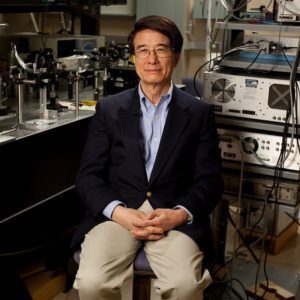Texas Research Summit: Why Texas Research Offers Promise for Energy Storage
 By Jeannie Kever, University of Houston Marketing and Communications
By Jeannie Kever, University of Houston Marketing and Communications
Energy has been the driving force of human civilization since the discovery of fire, but the invention of electric generators and electric motors in the 1870s marked a clear turning point. Almost 150 years later, most of us consume energy via electricity — the juice that powers everything from air conditioners to cell phones and laptop computers. Increasingly, even our cars may be powered not directly by gasoline or diesel, but by electricity.
But keeping up with growing demand, especially in the face of calls for a cleaner environment, has sparked one of the next great energy challenges. Texas scientists are working to develop materials that can store energy, allowing it to be deployed on demand, not only at the time of generation.
The modern movement took a leap forward in 1987, when physicist Paul C.W. Chu and members of his team at the University of Houston discovered a compound that acted as a superconductor at a temperature above the boiling point of liquid nitrogen, which promised to dramatically lower the cost of operating superconducting devices. Dr. Chu is now Founding Director and Chief Scientist at the Texas Center for Superconductivity at the University of Houston.
High temperature superconducting materials, along with batteries and other new materials, hold enormous promise for electrical energy storage, boosting the ability to use renewable and clean energy without compromising the quality and stability of the grid.
The late Nobel Laureate chemist Richard Smalley, from Rice University, ranked energy first on his Top Ten list of problems facing humanity over the next half-century. The rest of the list — water, food, environment, poverty, terrorism and war, disease, education, democracy and population — should be more easily resolved once questions surrounding energy, including reliable, low-cost energy storage, are answered, he said.
Texas researchers in both academia and industry, along with our booming wind energy sector, have pushed the state to the front of the field, boosted by federal funding from the Department of Energy, the National Science Foundation, the Department of Defense and other agencies. Greentech Media last year listed Texas as one of three states leading the effort to develop energy storage technologies, along with California and New York.
Solar power is slowly gaining market share here, and giant wind turbines stretch to the horizon in West Texas and the Panhandle. A $7 billion transmission project to connect wind farms with the state’s major cities only increased the need for a way to bank intermittent wind power and solar, relieving stress on the grid.
Right now, about 70 percent of global electric generation comes from fossil fuels — coal, oil and natural gas — while the International Energy Agency estimates 22 percent of world electricity generation is from renewable energy.
Experts point to electrical energy storage — converting excess electric energy to a different form, storing it and converting it back to electric energy when it is needed — as the necessary bridge to a lower-carbon future, reducing the greenhouse gases, acid rain and particulate pollution associated with fossil fuels. The expanding demands of mobile electronic devices and the rapidly developing electric vehicle market add to the urgency.
Scientists at the state’s top research universities, including the University of Houston, Rice, the University of Texas at Austin, Texas A&M University and the University of Texas at Dallas are on the job. Their projects range from improving the storage capacity of lithium ion batteries to creating flexible batteries, superconductors and other new materials, some of which incorporate advances in nanoscience and nanotechnology.
People have known for decades that excess energy can be stored in the form of magnetic energy in a superconducting coil, technology Chu says has been successfully tested using low temperature superconducting materials, which require expensive liquid helium to cool.
His discovery of high temperature superconductivity brought superconducting magnetic energy storage (SMES) a step closer to market.
Other key researchers at the Texas Center for Superconductivity include engineers Venkat Selvamanickam, who is focused on improving the storage capacity of magnets and leading efforts to create an Advanced Superconductor Manufacturing Institute, and Yan Yao, who works with new types of batteries.
Research in the private sector is surging, too. Utility transmission company Oncor last year released a report showing that 5,000 megawatts of energy storage could be added to the Texas grid to boost its efficiency. Smaller projects continue around the state, including one spearheaded by Duke Energy in Far West Texas. The Notrees Wind Energy Storage Project, partially funded by the Department of Energy, launched in 2012, using lead acid batteries to store electricity produced by the company’s wind farm. Duke earlier this year announced a plan to replace the lead acid batteries with lithium ion batteries in 2016.
Better batteries and other energy storage materials could ease some of the irritations of modern life, allowing cell phones and other personal electronic devices to last longer between charging. But more importantly, the materials also will help determine what sources of energy are used in the future, with huge implications for the climate.
Dr. Chu will be presenting on energy storage at the TAMEST Texas Research Summit on Friday, November 13, 2015. The Texas Research Summit will highlight the outstanding research and innovation taking place in Texas, while giving researchers in Texas a better understanding of federal agency priorities. The objective is to make Texas research institutions more competitive in seeking federal funding for research, which would lead to increased job growth and stronger research programs at major academic and industrial institutions. You can learn more about the summit here.

